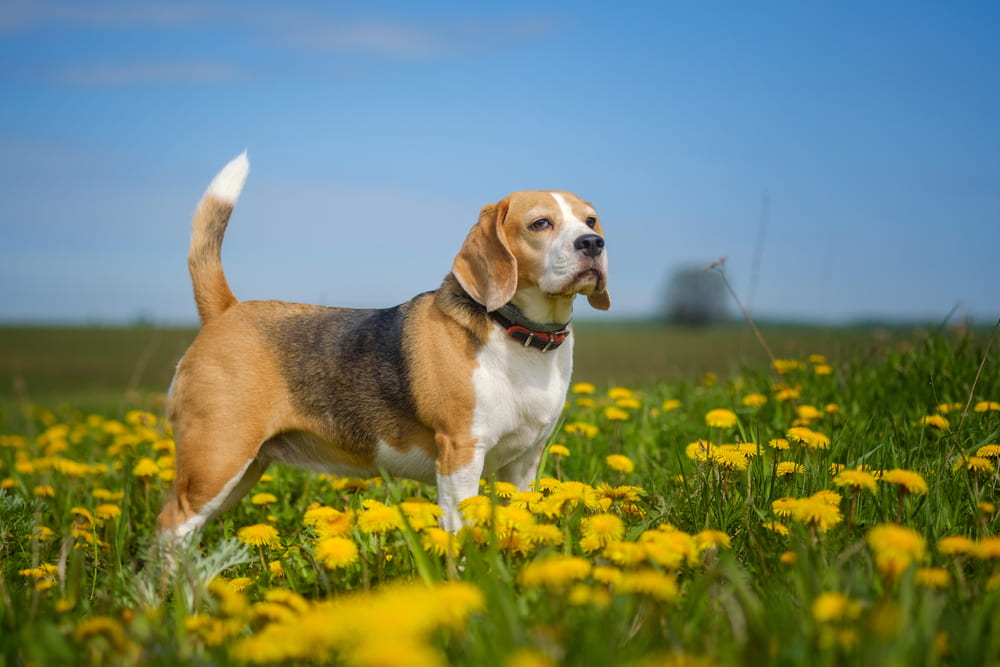Beagle

Breed Details
- Average Height: 13 - 15 inches
- Average Weight: 20 - 25 pounds
- Coloring: Typically white based with black, brown, tan, red, or lemon.
- Coat Type: Short, smooth, and dense double coat
- Dog Breed Group: Hound Group
- Average Lifespan: 12-15 years
-
Key Personality Traits:
Determined
Energetic
Good with Kids
Loyal
Hard Working
The curious and lovable Beagle with big floppy ears and an ever-wagging tail is among the top ten popular breeds in the United States. These small hounds are known for their howling and incredible sense of smell. Originally bred for hunting, Beagles have turned into friendly companions that love the company of their humans.
Since the breed tends to be noisy, they are not well suited for apartment living. They thrive in an environment where they can be themselves, running around a big yard sniffing away or making new friends at the dog park. With the proper training and care, your Beagle puppy can grow into a well-behaved, happy adult that will provide endless entertainment with their antics.
Keep reading to learn everything you need to know about this fascinating hound.
History and Origin

The Beagle can be traced back to the 5th century ancient Greece where dogs of similar size and purpose of hunting roamed the area. Although they existed for centuries, the breed came to be developed in the 1830s, from several breeds such as Talbot Hound, Northern Hound, Harrier, and the Southern Hound.
These dogs are scent hounds blessed with a great sense of smell, making them excellent for hunting rabbits and other small animals. These enthusiastic and active canines became popular in England in the 19th century where they were used for hunting.
The AKC (American Kennel Club) recognized the breed in 1885.
Beagle Physical Characteristics

There are two varieties of Beagle that are recognized: one that is 13 inches at the shoulder and the other between 13 and 15 inches tall. They are both considered to be sturdy hound dogs, and their smaller size meant that they could be carried on foot on hunting trips.
Some of the most distinctive features of a Beagle include their long, floppy ears, white coat with patches of brown, tan or lemon, muscular legs, and a white tip at the end of the tail. The white tip indicates the purebred status of the animal. Their eyes are typically hazel or brown and have a friendly expression.
Depending on the variety of the breed, male Beagles tend to weigh between 22 to 25 pounds and females 20 to 23 pounds. They reach adulthood around one and a half years.
Types of Beagles
The Beagle comes in a variety of colors with names like Lemon Beagle and Blue Tick Beagle.
A Lemon Beagle is a purebred dog with a two-tone coloring of white and yellow. The lemon color variation is a result of a recessive mutation and these dogs are very rare. The Blue Tick Beagle belongs in the Beagle family, but has unusual flecks of blue coloring all over the base color.
Pocket Beagles, as the name suggests, are much smaller than the already small Beagle. These are a result of progressively breeding together the smallest Beagles.
“Unfortunately, as a breed, they may consequently suffer from poor breeding practices and irresponsible breeders who prioritize their small size over their health,” says Jamie Richardson, Medical Chief-of-Staff at Small Door Veterinary in New York City. “Pocket Beagles may have a higher likelihood of suffering from the health concerns related to poor breeding practices mentioned above.”
Beagle Temperament

Beagles are loyal, loving, clever, and easy-going and they get along well with kids and other animals.
“Provided they’ve been socialized properly as puppies, they are generally very good with children and tend to make good family dogs,” says Richardson. “They also get along well with other pets, including cats, seeing them as part of their pack.”
She adds that Beagles are bred to be working dogs. They are highly intelligent and like to please their owners. However, when introducing training to your Beagle puppy or a recently adopted adult, keep in mind that the dog will respond well to positive reinforcement, with lots of praise, pets and treats.
These scent hounds are often employed by law enforcement and search and rescue teams. “Beagles can be seen working at airports, in NYC sniffing for bed bugs, and as hunting dogs in the South,” says Rachel Barrack of Animal Acupuncture in New York City.
“They are an excitable, high-energy breed requiring lots of training and exercise,” she adds.
Beagle Care Guide

Keeping and caring for a Beagle is an easy task. With proper training, exercise, diet, and grooming, these enthusiastic and sturdy dogs make excellent companions.
Diet and Nutrition
Beagles need a high-quality dog food that is appropriate for their life stage and size. “Beagles can be prone to obesity which can predispose to other health conditions,” warns Barrack.
“Owners should ensure they monitor their dog’s weight over time and take steps to rectify any weight gain if required,” suggests Richardson.
Exercise and Activity
Beagles are high-energy dogs requiring at least an hour of exercise daily. “Simply letting them out in the backyard isn’t sufficient,” says Richardson. “Beagles enjoy going for walks with their family, and many may enjoy running with their human, and playing games such as fetch.”
Because Beagles are scent hounds, they have a strong hunting instinct, and often cannot resist running off to follow a scent. Therefore, Richardson recommends keeping them “on a leash in unfenced areas, and ensuring you work on developing strong recall skills during training sessions.”
Grooming and Nail Care
Since they have short hair, Beagles do not require too much grooming. Brushing weekly is sufficient, although they tend to shed more in the spring as they lose their winter coat and need more regular brushing.
“They do not require bathing often, unless they get particularly dirty during a walk,” suggests Richardson. Get your Beagle’s nails trimmed every four to six weeks.
Beagle Health Issues

Beagles are generally healthy, but they can be prone to certain health conditions. According to Richardson, these include hip dysplasia, intervertebral disc disease, hypothyroidism, epilepsy, and luxating patellas. Intervertebral disc disease is a painful inflammation of spinal discs and luxating patellas involve a dislocated kneecap. Epilepsy is among the most common neurological disorders seen in dogs.
The Beagle’s long and heavy ears may also predispose the dog to ear infections. To help reduce frequent ear infections, Richardson suggests that their ears are regularly inspected for problems and cleaned if required.
Interesting Beagle Facts
Snoopy from the Peanuts cartoon is among the most popular cartoon characters representing the Beagle.
Odie from the Garfield comics was also a Beagle.
President Lyndon Baines Johnson had several Beagles while in the White House.
Queen Elizabeth I was a big fan of the Pocket Beagle.
The reason the Beagle was bred to have a white tip at the end of his tail has to do with finding the animal in the thicket, brush, or tall weeds while hunting.
Because of their amazing sense of smell, Beagles often work in search and rescue and as police dogs detecting illegal drugs and explosives at airports and crime scenes.
Popular Beagle Mixes
Beagles are often mixed with other dog breeds to combine their personalities and traits with those of other popular dogs. Here are a few of the more popular Beagle mixes.
- Beagador: This active dog is a mix of a Beagle and a Labrador Retriever.
- Cheagle: Mix between a Beagle and a Chihuahua.
- Beagi or Beagle Corgi: A mix of Beagle with Corgi.
- Bagel: A blend of a Beagle and a Basset Hound.
- Puggle: An adorable dog resulting from a Beagle and a Pug.
- Beaski or Busky: A blue-eyed combination of a Husky and a Beagle.
- Doxle: Mix of a Beagle and a Dachshund.
Beagle Adoption Tips and Things to Consider

If you are looking to add this vivacious little dog to your family, you have plenty of options. Unfortunately, because Beagles tend to bark or howl a lot, they end up in shelters regularly. Visit any of the local animal shelters and you are likely to find a Beagle.
These dogs also have the backing of a number of rescues across the country that are determined to find them loving homes.
When adopting, keep in mind that these pups are pack animals and love to be around their humans and other pets. They are prone to separation anxiety and could get destructive if left alone for long periods of time.
“Having a companion to play with, and providing interactive puzzle toys to stimulate their curious minds can help to keep them busy when they must be left alone,” suggests Richardson.
These dogs can overcome their separation anxiety with proper training early on and can also benefit from calming aids such as supplements, calming beds, and crates.
Beagle Rescues
If you’d like to adopt this breed and you don’t see one available at your local shelter, you can also reach out to one of these Beagle rescue groups.
- SOS Beagle Rescue, Inc.
- Beagle Freedom Project (rescues and rehomes Beagles used in lab research)
- Tampa Bay Beagle Rescue
- Arizona Beagle Rescue
- NorCal Beagle Rescue
- Beagle Rescue League, Inc.
- Seattle Beagle Rescue
- Dallas/Fort Worth Beagle Buddies
- Midwest Beagle Rescue, Education & Welfare
Beagle FAQs

Bringing a Beagle into your life is a big commitment, so it’s important to be prepared with as much knowledge about the breed as possible. Here are answers to some of the most commonly asked questions about this dog breed.
Do Beagles Shed?
Yes, Beagles do shed, however, it isn’t too noticeable. They do grow a thick winter coat, and tend to shed more in the spring.
How Long Do Beagles Live?
They can live up to 15 years, with an average life expectancy of 12-15 years.
How Big Do Beagles Get?
They can be up to 15 inches tall and be as heavy as 30 pounds if attention is not given to their diets. Beagles have a tendency to become overweight, so it’s important that pet owners pay attention to portion sizes and feeding guidelines.
Are Beagles Hypoallergenic?
No, Beagles are not hypoallergenic. They can cause allergies.
Do Beagles Bark A Lot?
Yes, these dogs love to howl and they can bark more than some other breeds.
Are Beagles Smart?
Yes, Beagles tend to be smart. But they are also bred to follow their noses, so if they get a whiff of something they want to chase, they will do so.
Beagle Pictures
With their floppy ears and big, loving eyes, it’s no surprise that these dogs are irresistible. Check out our gallery of Beagle pictures to see these pups doing what they do best.




















